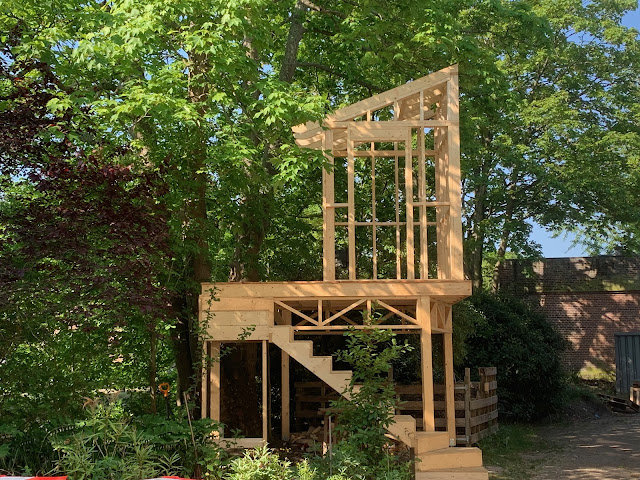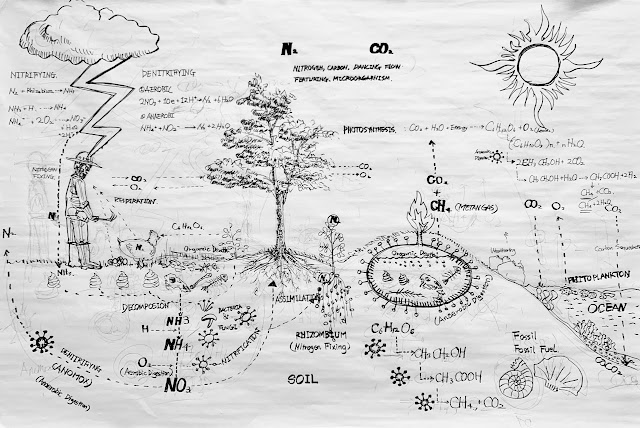I am writing to seek the understanding and support of the Rijksakademie community regarding my upcoming artistic research project. My goal is to present my work transparently and clearly to prevent any discomfort or misunderstanding. I sincerely appreciate your consideration and support in this matter.
2. Project Overview
Title: Dancing Flow of Microorganisms
This project is an experimental exploration of permaculture and ecological cycles. Specifically, I propose to construct a small treehouse at the southwestern edge of the Rijksakademie garden. This structure will function as a composting toilet, integrating a sustainable waste recycling system.
The project aims to collect organic waste—including human waste from the Rijksakademie community, garden byproducts, food scraps, paper waste, and sawdust—and process it into nutrient-rich compost. Once the construction is complete, I will oversee the collection and composting process until the end of 2026, carefully managing the entire system.
Through this experiment, I hope to physically engage my own body in experiencing the natural nutrient cycle—absorbing nutrients from the atmosphere, consuming food grown from the soil, and ultimately returning bodily waste to the earth as compost—thus personally sensing the cyclical transformation of matter and energy.
3. Participants and Key Subjects
This project involves two primary groups of subjects:
The Rijksakademie Community
As artists and professionals in Rijksacademie, we live and work within this shared space, engaging in metabolic processes regularly. Modern sanitation practices have led us to perceive human waste as undesirable or even hazardous. However, historically, human manure has been valued as an important composting material in various cultures worldwide. Through this project, I aim to reconnect this lost perception with the natural soil cycle.
Microorganism Communities
As an artist, I have frequently worked with human communities. In this project, I extend my engagement to invisible microbial communities, such as fungi, bacteria, and protozoa. The project's success hinges on their ability to establish stable settlements and residences within the soil. Industrial agriculture, with its emphasis on rapid growth and high yields, has increasingly relied on chemical fertilizers, disrupting the nitrogen cycle and diminishing the role of soil microorganisms. As a result, soil sustainability is undermined, leading to increased nitrogen waste, eutrophication, and greater energy consumption for water purification and sanitation. This project seeks to highlight the importance of microbial life in restoring ecological balance.
4. Timeline
With approval, I plan to begin construction next week, with an estimated completion time of three to four months. The schedule may be adjusted depending on unforeseen circumstances.
Once operational, I invite community members to participate by using the composting toilet. Based on existing composting methods, the transformation of waste into nutrient-rich soil takes approximately six months. I hope to use this compost in the Rijksakademie garden for cultivating vegetables and flowers, which may, in turn, be used in the Cantina or for communal meals.
This experiment will continue for the duration of my residency and will conclude with the deconstruction of the structure, reinforcing the natural cycle of creation and decay.
5. Addressing Concerns and Risk Management
The primary concerns associated with this project are odor and sanitation.
Ammonia (NH3) generation is a natural step in the nitrogen cycle. Microbial digestion converts ammonia into nitrate (NO3), a nutrient that fertilizes soil. This transformation eliminates odor and results in a rich, earthy compost. Maintaining the correct balance is crucial, requiring careful management, including the maintenance of an aerobic environment and the addition of organic materials such as sawdust, leaves, grass, and small branches.
Once a container reaches capacity, it will be sealed, stored separately, and replaced with a fresh one to ensure hygiene and prevent contamination. I am fully committed to managing this project in a way that maintains a pleasant and clean environment. Additionally, I aspire to create a meditative and contemplative space within the treehouse.
6. Project Significance and Long-Term Goals
Conceptual Metaphor
Through this project, human waste generated by the Rijksakademie community will be transformed into a valuable resource in collaboration with microorganisms. The Rijksakademie fosters interdisciplinary collaboration, requiring a carefully balanced environment to sustain creative practice. This project serves as a metaphor for such a balance, emphasizing the interconnectedness of all processes.
Sustainable Nutrients
Nitrogen, a major component of the atmosphere, enters organic life through the food chain. It is a fundamental element in proteins and amino acids. Traditionally, organic waste returns these nutrients to the earth, sustaining ecological cycles. However, industrial nitrogen extraction has dramatically increased productivity while simultaneously disrupting natural nitrogen cycles. Excessive nitrogen waste contributes to ocean eutrophication and necessitates large-scale chemical treatment plants, further increasing energy consumption.
By adopting slower, organic processes, this project seeks to promote energy-efficient and sustainable nitrogen fixation, fostering healthier microbial soil ecosystems.
Social Design
This experiment ultimately aims to explore its potential as a sustainable design solution for challenging environments. By demonstrating a self-sustaining nutrient cycle, I hope this project can offer practical insights for communities lacking basic infrastructure while also fostering a vision of coexistence with others.

(Korean)
1.목적
제가 라익스 커뮤니티에 이 글을 쓰는 이유는 앞으로 진행될 저의 실행 계획에 관하여 여러분의 따뜻한 이해를 구하기 위해서 입니다. 저는 저의 실험이 라익스에서 생활하는 여러분에게 불편을 끼치거나 당혹감을 주지 않기를 바랍니다. 그래서 저의 작업계획에 대해 최대한 명확하게 설명을 드리고 정중하게 양해를 구하고자 합니다.
2.내용
TITLE : DANCING FLOW OF MICRO ORGARNISM
-본 실험은 일종의 퍼머컬쳐 순환 시스템에 관한 것입니다.
-저는 라익스아카데미 서남쪽 구석진 정원에 작은 트리하우스를 건설하고자 합니다.
-트리하우스의 용도는 아담한 화장실입니다.
-이 작은 집은 퇴비화 시스템과 연동됩니다.
-라익스 공동체 구성원의 대변, 정원 부산물, 음식물 쓰레기, 나무쓰레기, 종이쓰레기 등을 수집하여 퇴비화 하고자 합니다.
-시설을 완성하고 난 후 2026년까지 장기적으로 관리하면서 수집과 퇴비화 과정을 반복할 예정입니다.
-지구의 영양소가 대기에서 땅으로 땅에서 음식으로 음식에서 분뇨로 분뇨에서 흙으로 되돌아가는 과정을 관찰하고 몸으로 경험하고자 합니다.
3.누가 주체인가
두 종류의 주체가 이번 프로젝트의 숨은 주인공들 입니다.
첫번째는 라익스아카데미 공동체입니다.
우리는 예술가 및 예술 기관의 전문가들입니다. 우리는 이곳을 중심으로 생활하며 적어도 일주일에 몇 번 이상의 대사 활동을 합니다.
근대화 이후 인간의 배설물은 질병의 원인 혹은 역겨운 것으로 간주 되었지만 과거에는 세계 각 지역에 따라 귀중한 비료 자원으로 활용되는 전통이 있었습니다. 위생이라는 이름으로 우리 몸의 감각에서 추방된 흙의 순환 고리에 다시 연결되는 경험을 함께 나누고자 합니다.
두번째는 미생물 집단입니다.
저는 커뮤니티와 함께 프로젝트 작업을 해왔던 예술가입니다.
이번 프로젝트에 초대하는 주요 커뮤니티는 박테리아와 곰팡이와 같은 눈에 보이지 않는 존재들입니다.
이번 실험의 성패는 바로 이들의 정착 및 거주의 성공 여부에 달려 있습니다.
현대 농업 기술은 증가하는 인구를 부양하기 위해 화학적으로 질소 순환고리를 단절시켰고 빠른 성장을 추구했습니다.
더 빠른 성장과 생산력의 증대는 미생물이 땅에 자리 잡을 수 있는 시간과 공간을 허락하지 않았습니다.
결과적으로 땅의 지속성은 교란되었고 더 많은 폐기물, 바다의 부영양화, 대규모 정화 처리시설 건설, 더 많은 에너지와 수자원의 소비 등 악순환 사이클이 가속화 되었습니다.
4.타임테이블
라익스 커뮤니티의 동의가 이루어지면 다음 주부터 건축을 위한 준비가 시작됩니다. 오두막 트리하우스 건축 기간은 대략 3-4개월 정도 예상되며 상황에 따라서 변동 될 수 있습니다. 건축이 완료되면 라익스 커뮤니티 구성원은 누구나 귀중한 질소비료 기증자가 될 수 있습니다. 여러분의 귀중한 분뇨를 이곳에 배설해 주시기를 간곡히 요청 드립니다. 분뇨가 향기로운 흙으로 변화하기까지 대략 6개월 정도 소요됩니다. 내년 봄부터 라익스아카데미의 정원에 그 퇴비화 흙을 사용하여 경작을 할 예정입니다. 내년 가을에는 수확된 야채로 함께 음식을 만들어 먹거나 CANTINA 에서 활용할 수 있기를 희망합니다.
이 실험은 제 레지던시 기간 동안 지속적으로 관리 될 것이며 저의 레지던시 종료 시점과 함께 붕괴 될 것입니다. 건축물 또한 자연의 일부로서 생성과 붕괴는 자연스러운 일이라고 생각합니다.
5.예상되는 문제와 위기 관리
-이번 작업에서 가장 우려 되는 부분은 위생 문제와 냄새 문제일 것입니다.
-배설물의 퇴비화 과정에서 암모니아(NH3)의 발생은 사실 자연스러운 과정입니다.
-미생물의 소화과정을 통해 암모니아(NH3)는 무기질 비료인 질산염(NO3)으로 변화되어 토양에 비옥한 영양분을 제공하게 됩니다.
-냄새가 거의 나지 않고 미생물이 잘 번식할 수 있는 이상적 환경을 제공하기 위해 충분한 산소 공급과 더불어 분쇄된 톱밥, 죽은 나뭇가지, 나뭇잎과 같은 유기물 쓰레기의 적절한 배합 비율 중요합니다
-다 채워진 컨테이너는 정기적으로 솎아 주어야 하며 밀봉하여 따로 보관하고 새 컨테이너로 교체 될 것입니다.
-정기적 컨테이너 교체, 호기 환경 조절, 수분 조절 등 관리를 통해서 최대한 불쾌한 일이 일어나지 않도록 최선을 다할 것을 약속 드리겠습니다.
-트리 하우스 화장실은 독서 사색 등을 즐길 수 있는 장소로서 최대한 쾌적한 환경으로 디자인 하도록 노력하겠습니다.
6.의의 와 장기목표
개념적 비유
-라익스 아카데미 구성원들의 배설물은 문자 그대로 미생물과 협업을 통하여 귀중한 자원으로 재생산 됩니다.
-예술가들과 전문가들이 다학제적으로 협력하는 라익스 아카데미에서 이상적인 창작 환경을 만들기 위해서 매우 섬세한 환경 구성과 균형 감각을 필요로 합니다.
-이 실험은 예술과 환경에 대한 일종의 개념적 비유라고 볼 수 있습니다.
지속가능한 순환사이클
-대기의 대부분은 질소로 구성되어 있습니다.
-질소는 먹이사슬을 통해 다양한 형태로 유기체에 흡수되어 생명체 유지에 필수적인 단백질과 아미노산을 구성합니다.
-모든 유기생명체는 죽음과 배설을 통해 다시 토양으로 그 영양소를 돌려보냅니다.
-화학적인 질소 추출 기술을 통해 농업 생산량은 극적으로 증가 했지만, 이러한 질소 순환 사이클은 심각하게 교란되었습니다.
-더 많은 농업 생산을 위해 더 많은 화학비료를 필요로 하는 현대 환경은 지나친 질소폐기물과 해양의 부영양화를 일으키고 이를 처리하기 위한 더 큰 화학적 정화시설 건설과 에너지 소비를 필요로 하게 됩니다.
-다소 번거롭고 느린 속도의 질소 포집 기술인 '퇴비화 화장실'은 에너지를 훨씬 적게 소비할 뿐만 아니라 토양의 건강한 생태계를 형성하여 지속 가능한 생산을 가능하게 합니다.
사회적디자인
-마지막으로 이 실험은 극한의 환경에 놓여있는 공동체에 적용할 수 있는 사회적 디자인 실험의 일환으로 기획되었습니다.
-기본적인 기반시설이 없는 지역에서 지속 가능한 생존기술로서 활용될 수 있을 뿐만 아니라 타자와 공존의 비전을 제시할 수 있는 실험이 되기를 희망합니다.
2025.3.19
Heong Uk Choi





댓글
댓글 쓰기